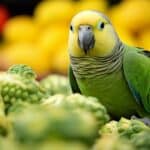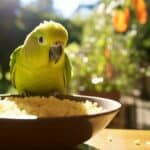If you own a kakariki or are considering getting one as a pet, you may wonder if feeding them peas is safe. Kakarikis are known for their playful personalities and distinct green and red feathers, but they also have specific dietary needs that must be met to keep them healthy and happy. In this article, we’ll dive into kakarikis’ diets, exploring whether these birds can safely consume peas and providing insight into their overall nutritional needs.
Can kakarikis eat peas? Yes, kakarikis can eat peas. Kakarikis, or New Zealand parakeets, can safely consume peas as part of their diet. These vibrant and energetic birds benefit from a varied diet that includes fresh vegetables, fruits, and seeds. Peas provide essential nutrients and can be a delightful treat. When introducing new foods, always ensure moderation and monitor for any adverse reactions.
Key Takeaways:
- Kakarikis have specific dietary needs to be met to keep them healthy and happy.
- This article will explore whether kakarikis can safely consume peas and provide insight into their nutritional needs.
- We will also suggest other suitable foods for kakarikis that can contribute to a well-rounded diet.
- Feeding tips and considerations will also be discussed to ensure your kakariki receives the right nutrients and maintains a healthy weight.
Understanding Kakarikis’ Dietary Preferences
Kakarikis are fascinating birds with a unique set of dietary preferences. As omnivores, they enjoy a varied diet of plant and animal matter. However, their natural diet mainly comprises seeds, fruits, berries, and insects.
When kept as pets, kakarikis often exhibit specific food preferences influenced by their upbringing and surroundings. For example, they may prefer certain fruits or vegetables based on what they were fed during their early development.
It’s important to understand a kakariki’s natural dietary preferences and cater to them accordingly. Offering a variety of foods can help ensure optimal health and prevent boredom or behavioural problems. Consult with a veterinarian specialising in bird care or an experienced avian breeder to learn more about the specific dietary needs of kakarikis.
A Balanced Diet for Kakarikis
Giving your kakariki a proper diet is essential for their health and well-being. A balanced diet for these birds should include a variety of foods to ensure they get all the necessary nutrients.
Your kakariki’s diet should consist of approximately 70% good quality pellet or seed mix, 20% fruits and vegetables, and 10% other foods including nuts and grains.
| Food Group | Examples |
|---|---|
| Pellets/Seed Mix | Pellet mix, millet, sunflower seeds |
| Fruits and Vegetables | Apple, banana, carrot, kale, spinach |
| Nuts and Grains | Almonds, walnuts, quinoa |
It’s important to note that giving your kakariki too many fatty or sugary foods can lead to obesity, which can cause health problems. Therefore, providing a balanced diet and monitoring their weight regularly is essential.
By following these guidelines, you can help ensure that your kakariki receives the nutrients they need for a healthy and happy life.
Can Kakarikis Safely Eat Peas?
If you’re wondering whether your kakarikis can safely consume peas, the answer is yes! Peas are safe for kakarikis to eat and can even provide some nutritional benefits.
“Peas are a good source of vitamins B1, B2, and K, as well as fiber and protein. They also contain antioxidants that can benefit your kakariki’s health.”
However, it’s essential to remember that peas should not make up a significant portion of your kakariki’s diet. While they are a healthy addition, kakarikis require a varied and balanced diet to stay healthy.
When introducing peas into your kakariki’s diet, start with small amounts and gradually increase the portion size over time. Monitor your bird’s reactions to the peas and make adjustments as necessary.
If your kakariki seems to enjoy peas, you can feed them as a treat once or twice a week. However, it’s still important to ensure they receive a wide variety of other foods to ensure they receive all the nutrients they need.
Peas are a safe and healthy addition to your kakariki’s diet. Just be sure to introduce them gradually and provide a balanced diet that includes a variety of other foods.
Nutritional Value of Peas for Kakarikis
Peas are a great addition to a kakariki’s diet due to their high nutritional value. They are an excellent source of vitamins A, C, and K, essential for maintaining healthy skin, feathers, and bones. Peas also contain B vitamins, including thiamine, which aids digestion, and folate, which plays an important role in overall health.
Peas are also a good source of essential minerals like iron and potassium, which help support vital bodily functions. Moreover, the high fibre content in peas helps regulate the digestive system and prevent constipation.
Incorporating peas into your kakariki’s diet can provide various health benefits, including improved immune function, increased energy levels, and better overall health and vitality.
Note: While peas are a nutritious addition to a kakariki’s diet, it is essential to ensure they are introduced gradually and in moderation, as a sudden change in diet can cause gastrointestinal distress.
Introducing Peas into a Kakariki’s Diet
If you’re considering adding peas to your kakariki’s diet, it’s important to do so gradually. Too much too soon can lead to digestive upset and other issues. Start by offering a small amount of cooked, unsalted peas once or twice weekly.
Monitor your kakariki’s behaviour and droppings to ensure they tolerate the peas well. If you notice any changes, reduce the amount of peas offered or discontinue them altogether.
It’s also important to consider the portion size of peas when feeding them to your kakariki. Aim for about one teaspoon of cooked peas for every 25 grams of body weight per serving.
Finally, remember that peas should not make up most of your kakariki’s diet. While they offer some nutritional benefits, a balanced diet should consist primarily of fresh fruits and vegetables, high-quality pellets, and occasional protein sources.
Other Suitable Foods for Kakarikis
While peas can be a healthy addition to a kakariki’s diet, it is important to ensure they consume a variety of other foods. Here are some other suitable options:
- Fruits: Kakarikis love fruit but should be given in moderation due to its high sugar content. Try offering small amounts of apple, berries, and melon.
- Veggies: Raw or lightly steamed veggies like carrots, bell peppers, kale, and spinach can provide important vitamins and minerals.
- Grains: Cooked brown rice, quinoa, and whole grain pasta can supply fibre and energy.
- Protein: Cooked, unseasoned chicken or turkey can be offered in moderation, as well as boiled eggs and tofu.
Remember always to introduce new foods gradually and monitor your kakariki’s response. A balanced diet with various foods can help ensure your bird stays healthy and happy.
Feeding Tips and Considerations
When it comes to feeding your kakariki, there are a few important tips and considerations to keep in mind to ensure they receive the right nutrients and maintain a healthy weight.
Firstly, it’s essential to provide a balanced diet that includes a variety of foods. Aim to offer a mix of fresh fruits and vegetables, quality pellets, and seeds to provide all the essential nutrients your bird needs.
Secondly, be mindful of portion sizes. While filling up your bird’s dish is tempting, overfeeding can lead to obesity and other health problems. Generally, offer a small amount of food your bird can finish within a few hours and adjust the portion size accordingly if needed.
Thirdly, monitor your kakariki’s weight to ensure they are maintaining a healthy body condition. A healthy bird should have a visible waistline and be able to move freely without any signs of laboured breathing.
Fourthly, avoid offering foods high in fat, salt, or sugar, as these can lead to health complications down the line. In addition, steer clear of any toxic foods that can harm your bird, such as chocolate, avocado, and alcohol.
Lastly, ensure your bird always has access to fresh, clean water. Change the water in their dish daily to prevent bacteria or toxins from building up and causing health problems.
Monitoring Your Kakariki’s Health
As you provide a balanced diet for your kakariki, monitoring their health is essential to ensure they remain in top condition. One way to do this is to observe their behaviour and appearance closely. Check for any changes in their natural behaviour, such as a loss of appetite or lethargy, which may indicate an underlying health issue.
You should also keep an eye on your kakariki’s weight. While small fluctuations in weight are normal, significant weight loss or gain can be a sign of an underlying issue. Regularly weighing your bird and keeping a log of their weight can help you monitor for any significant changes.
Additionally, it’s essential to maintain proper hygiene around their feeding and living areas to prevent the spread of disease. Clean their feeding dishes and surrounding areas regularly, and make sure their living space is kept clean and dry.
If you notice any concerning changes in your kakariki’s behaviour or appearance, seeking veterinary advice is crucial. Monitoring your bird’s health and providing a balanced diet can help ensure they live a long and healthy life.
Conclusion
Now that you better understand kakarikis’ dietary preferences and nutritional needs, you can ensure that your feathered friend is provided with a balanced and healthy diet. It is important to remember that while kakarikis can safely consume peas in moderation, they should not be relied upon as a primary source of nutrition. Instead, aim to provide a variety of fresh vegetables, fruits, nuts, and high-quality pellets or seeds to promote optimal health.
Remember to monitor your kakariki’s health and weight regularly, as their diet is crucial to their overall well-being. With a little attention and care, you can help your kakariki thrive and lead a happy, healthy life.
FAQ
Q: Can kakarikis eat peas?
A: Kakarikis can safely consume peas as part of a balanced diet, but it’s important to introduce them gradually and in moderation.
Q: What do kakarikis eat?
A: Kakarikis have natural dietary preferences that include fruits, vegetables, seeds, and insects.
Q: What should be included in a balanced diet for kakarikis?
A: A balanced diet for kakarikis should include a variety of fruits, vegetables, seeds, and high-quality pellet or seed mixes designed specifically for parrots.
Q: Are peas safe for kakarikis?
A: Peas are generally safe for kakarikis to eat, but they should be cooked or lightly steamed to ensure easier digestion.
Q: What nutritional value do peas provide for kakarikis?
A: Peas are a good source of vitamins A, B, and K, as well as important minerals like iron and potassium.
Q: How can I introduce peas into my kakariki’s diet?
A: To introduce peas into your kakariki’s diet, start by offering small amounts mixed with their regular food and gradually increase the portion size over time.
Q: What other foods are suitable for kakarikis?
A: Other suitable foods for kakarikis include leafy greens, carrots, apples, berries, and lean protein like boiled chicken or eggs.
Q: Any feeding tips and considerations for kakarikis?
A: It’s important to provide fresh food and water daily, avoid sugary or salty foods, and monitor their weight to maintain a healthy size.
Q: Why is monitoring my kakariki’s health important?
A: Monitoring your kakariki’s health is crucial to catch any potential issues early on. A nutritious diet plays a significant role in their overall well-being.



Have comments or questions about this article? Then get involved!
Spotted an error or something we have missed? Let us know